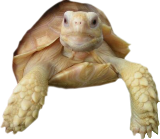
Riparian Farms

Care Sheet: African Spurred & Leopard Tortoises
Leopard Tortoise (Geochelone pardalis) and African Spurred tortoise (Geochelone sulcata) are large African Species. The Leopard Tortoises grows to 14 to 18 inches with reports of tortoises over 20 inches. The African Spurred Tortoise grows to 20 to 26 inches with reports of over 30 inches and 200 pounds. The care of both these species is very similar except that the African spurred tortoise requires much more room and digs burrows. The Leopard Tortoise is not quite as hardy (can't take as much cold or neglect).
When you receive your tortoise it should be immediately soaked in shallow lukewarm water for about 20 minutes. Hatchling tortoises should be housed indoors. They can be put outside to receive natural sun light, but should be watched and be able to get out of the sun when they get warm (if not they could become over heated and die). 6-inch tortoises can be kept outside during warm months when night temperatures are above 65 degrees and days are sunny. They cannot endure cool, overcast and rainy days. Larger tortoises can be housed in greenhouses, or in warm rooms with the tortoise confined in a large sturdy pen. Neither of these species hibernates.
Hatchling tortoises can be maintained in a large glass aquarium, or a large plastic box such as a sweater box. The aquarium should be lighted with a good UL bulb and there should be a basking light on one side of the aquarium or box. The temperature at night should be above 65 degrees and days should be above 80 degrees. The tortoises require a basking light so they can elevate their body temperature to 85 to 90 degrees which aid in digestion (this is especially important to African Spurred Tortoises). Larger tortoises that are maintained outside have the ability to elevate their body temperature by basking in direct sun light (75 to 80 degrees is adequate for basking outside. It has been shown that tortoises can raise their body temperature to acceptable levels by basking in the sun even when the air temperature is as low as 60 degrees)
Leopard Tortoise and African Spurred Tortoises are grazers and herbivores. They do not eat meat of any kind and do not require any fruit. Larger tortoises can be maintained on lawns or fed hay. No other supplements are required. If grass is not available adults can be fed dark green vegetables and commercial tortoise diets. If they are fed only dry foods (such as dry tortoise diets or dry hay) they must have water available every day. If the tortoises have fresh greens or grass available they should still be watered two or three times per week or more often if temperatures are high. They should always have shade available so they can get out of direct sun when they have warmed up. A hide box or turtle house is recommended.
Hatchling tortoises should be fed daily. A diet of chopped greens (kale, endive, mustard, dandelions, etc.) and/or a commercial tortoise diet (15 to 18 percent protein) should be fed to the tortoises. They should be soaked in shallow lukewarm water at least every other day. If your tortoise is kept warm fed and watered regularly, and given adequate room it should live for years. Small tortoises grow between 2 and 4 inches per year.